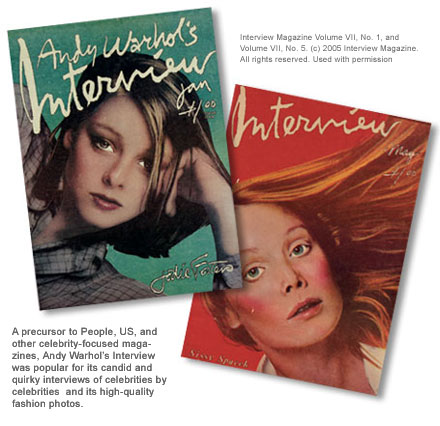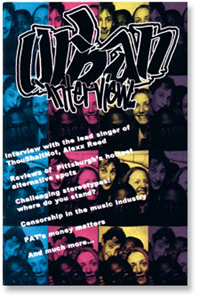Back

Begun in the fall of 1969 as a way to get press passes
to the Seventh Annual New York Film Festival, Andy
Warhol’s
Interview magazine has morphed over the years from
an underground newsletter and photo essay about the 1970s’ Studio
54 crowd, to a chic, mainstream magazine that defines and
displays what is cutting edge today in the United States—or
at least New York City. It also serves as inspiration for
a talented group of teenagers who work with the education
staff at The Andy Warhol Museum to create their own magazine
called Urban Interview.
“
Andy Warhol used Interview to write about what interested
him and what was happening in the arts and cultural worlds
surrounding him,” says Matt Wrbican, assistant archivist
at The Andy Warhol Museum. “He pioneered the idea
of celebrities interviewing celebrities, and, over time, Interview became well-known for its intimate—and
often humorous—look at the personal, professional,
and social lives of the rich and famous.”  Loosely
based on Warhol’s Interview, which is also
famous for its high-quality fashion images by A-list photographers,
Urban Interview encourages Pittsburgh-area high school
students to interview and photograph people from a wide
range of backgrounds and professions, and showcases the
students’ own opinions, poetry, writing styles, and
visual art. Loosely
based on Warhol’s Interview, which is also
famous for its high-quality fashion images by A-list photographers,
Urban Interview encourages Pittsburgh-area high school
students to interview and photograph people from a wide
range of backgrounds and professions, and showcases the
students’ own opinions, poetry, writing styles, and
visual art.
“
The education staff at The Warhol developed the Urban
Interview program in 1998 as a way to keep Warhol’s legacy
alive and to make his work more relevant to kids today,” says
Mary Tremonte, an artist-educator at The Warhol who has
been managing the program for the past two years. “Most
importantly though, it was created to help students with
interests in art, writing, design, and magazine production
learn vital interview, computer, and team-building skills
that can help them achieve their professional goals later
in life.”
The team of four teens that produced Urban
Interview 2005 took a page out of Warhol’s book by
deciding to focus on the underground art and music scene
this year.
“
It was really cool to learn how to put my art background
to use to create a really slick magazine that talked all
about things that are important to me and my friends right
now,” says Ian Kazimer, a member of the 2005 Urban
Interview editorial team. “And while it definitely
was a lot of fun, it wasn’t playtime. It was a real
job that we all took seriously and learned a lot from.”
When
asked who read his Interview magazine, Warhol once replied, “Our
friends read it, and whoever is on the cover reads it.” And
when questioned about what he was trying to achieve with
his publication, Warhol responded, “We
want to be entertaining.” Today, the teens who put
Urban Interview together have the same goal and are writing
and designing for the same audience: they want their magazine
to entertain—and impress—their friends.
In the
letter that introduces Urban Interview 2005 to its readers,
the editorial team writes:
“
UI is inspired by Andy Warhol’s Interview magazine,
which (like his other endeavors) challenged society’s
standards and rules. UI is your source for intelligent
entertainment…[and] some serious articles that reflect
the opinions of the editors on topics such as stereotypes,
censorship, public transportation, and the music of the
soul.” No doubt, Warhol would have been proud.
Urban Interview is funded by YouthWorks, a local non-profit
institution that develops programs with other community
organizations to help create employment and career development
opportunities for young people.
Education programs at The
Andy Warhol Museum are made possible by generous gifts
from Mellon Financial Corporation, The
Grable Foundation, Highmark Blue Cross Blue Shield, The
National Endowment for the Arts, Pennsylvania Council
on the Arts, Surdna Foundation, W.L.S. Spencer Foundation,
Verizon, and YouthWorks.
Back
| Top |